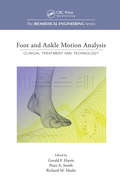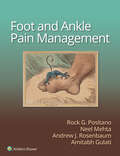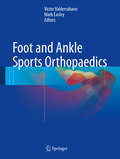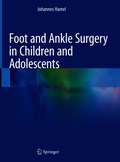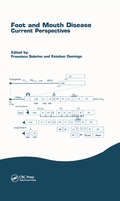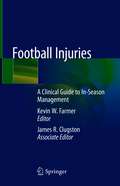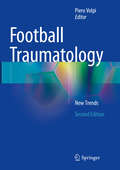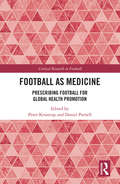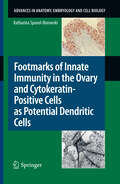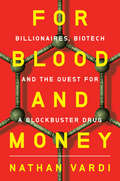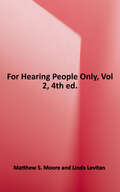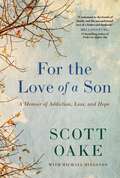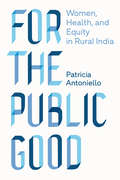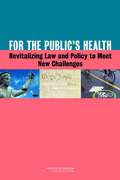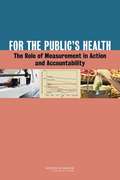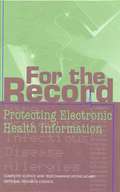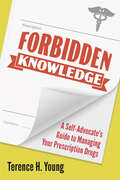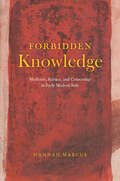- Table View
- List View
Foot and Ankle Motion Analysis: Clinical Treatment and Technology
by Gerald F. Harris Peter A. SmithHuman motion analysis or gait analysis is used throughout the country and the world in clinics for pre-surgical planning and postsurgical follow-up. Only recently have technological advances truly begun to meet medical needs by supplying more accurate analytical data from which to make educated assessments of dynamic foot and ankle pathology. A com
Foot and Ankle Pain Management
by Amitabh Gulati Rock G. Positano Neel Mehta Andrew J. RosenbaumOffering a comprehensive, multidisciplinary approach to a complex topic, Foot and Ankle Pain Management is a first-of-its-kind reference to this commonly presenting problem. Drs. Rock G. Positano, Neel Mehta, Andrew J. Rosenbaum, and Amitabh Gulati provide authoritative clinical guidance from areas of expertise in musculoskeletal podiatry, pain medicine, physiatry, and orthopaedic surgery. This first-line resource covers relevant anatomy, pain conditions, and treatments in a well-organized, easily referenced manner—offering a complete approach to care for foot and ankle specialists, pain medicine specialists, primary care physicians, pediatricians, and other clinicians who encounter patients with foot and ankle pain.
Foot and Ankle Sports Orthopaedics
by Mark Easley Victor ValderrabanoThis book provides a comprehensive review of the diagnosis, management and treatment of sports injuries to the foot and ankle. The editors have assembled a list of contributors at the top of their field to define the medical management, treatment and surgery for the most common and highly debilitating sports injuries. Currently, foot and ankle injuries are the most common musculoskeletal injuries, thus this book fills the clear need for a state-of-the art resource that focuses upon this growing area of orthopaedic practice. Foot and Ankle Sports Orthopaedics is highly relevant to orthopaedic surgeons, sports orthopaedic surgeons and medical professionals dealing with sports injuries around the F&A. With clear and didactic information and superb illustrations, this book will prove to be an indispensable learning tool for readers seeking expert guidance to further their surgical skills in this area.
Foot and Ankle Surgery in Children and Adolescents
by Johannes HamelDrawing on the latest evidence, this book guides readers through the diagnosis and surgical treatment of the most common pediatric foot and ankle deformities and pathologic conditions. Thanks to a wealth of images, readers will gain new insights and learn new concepts for several surgical procedures – with a special focus on all aspects of clubfoot treatment, new techniques in coalition surgery and new concepts in planovalgus and cavovarus correction. The book also features a number of cases that observe a given condition over an extended period: idiopathic clubfoot, subtle and rigid planovalgus deformity, skew foot, cavovarus foot, supramalleolar and forefoot deformities and others. For each surgical technique, it thoroughly discusses the indications, provides valuable tips, and highlights potential pitfalls. Functional aspects are moreover emphasized by pedographic observation. This comprehensive book offers a valuable asset for foot and ankle surgeons, pediatric orthopedic surgeons, physical therapists and pediatricians alike.
Foot and Ankle Trauma Injuries: Atlas of Surgical Procedures
by Walter Daghino Alessandro Massè Daniele MarcolliThis full-color atlas offers a systematic guide to performing surgeries for the most common traumatic lesions of the foot and ankle. It features a wealth of didactic illustrations, achieved with a particular technique employing colors and transparencies that also reveals those anatomic structures that are not visible in the surgical field, but essential to a good outcome. Divided into seven chapters, the book provides coverage of all anatomic segments, presenting each topic logically and explaining all types of lesions, even the most difficult, complicated or infrequent ones; discussing the indications and objectives of the surgical treatment; describing the surgical technique (patient positioning, approach, tips and tricks for reduction, means of osteosynthesis); and providing recommended post-operative protocols. Unique in its exclusive focus on foot and ankle traumatology, this atlas offers an invaluable resource for all surgeons and residents who need a systematic overview of the main treatments options for these segments.
Foot and Mouth Disease: Current Perspectives
by Esteban Domingo Francisco SobrinoThe shock following the recent outbreak of foot-and-mouth disease (FMD) in the UK dispelled the notion that this disease was permanently under control and could be forgotten. FMD proved to be an endemic disease in many countries and continues to pose a major threat to animal health worldwide. The development of more effective and socially acceptabl
Football Injuries: A Clinical Guide to In-Season Management
by Kevin W. FarmerIn-season management of (American) football injuries presents a unique set of problems and considerations. Trying to safely return players to play is of great concern from Pop Warner up to the NFL, and managing injuries during the season with the plan of operative repair in the off-season is also a unique concern with these athletes. Management during the season to allow return to play, while minimizing the risks of further injury, is of utmost importance. This unique book will focus on the management of football injuries during the season and on the sidelines. It will focus on both operative and non-operative treatments that allow safe return to play, utilizing not only the latest scientific literature supporting in-season decisions, but also the experiences of the authors, who have spent many years treating these athletes. Divided into sections on orthopedic and medical considerations, the first part is organized anatomically to present the breadth of injury and treatment strategies available, from injuries to the shoulder and elbow, to ACL/MCL/PCL tears and sprains, to tendinopathies and sports hernia, among many other conditions. The second section covers diverse medical topics germane to football, including heat and cardiac issues, traumatic brain injury, mental health and infectious disease considerations, pain management, and the expanding role of platelet-rich plasma (PRP) in non-operative treatment. Presenting the most recent clinical evidence alongside time-tested management techniques, Football Injuries will be a valuable addition to the practices of orthopedic surgeons, sports medicine specialists, sideline medics and athletic trainers, and primary care physicians treating these athletes.
Football Traumatology
by Piero VolpiThis book provides a comprehensive guide to the evaluation, treatment, and rehabilitation of musculoskeletal injuries commonly experienced by football (soccer) players. It will be of particular value for orthopedists and sports medicine practitioners, and will provide the information required by trainers and medical staff regarding the traumatic lesions associated with the sport. It is also anticipated that the book will assist in reducing the risk of trauma in footballers. The new edition has been revised to reflect advances in knowledge and practice and will be more valuable than ever, given that the risk of trauma continues to increase owing to the intensity and speed of modern football, the current training methods, and technical and tactical innovations. Injuries are a major adverse event during a footballer's career, and they require appropriate medical and/or surgical treatment and rehabilitation. The overviews provided in this book will help in delivering such care.
Football as Medicine: Prescribing Football for Global Health Promotion (Critical Research in Football)
by Peter Krustrup Daniel ParnellIt is beyond dispute that physical activity is good for us, but what are the benefits, challenges and impacts of sport on health? This is the first book to focus on football in the context of health from individual, public and population-level perspectives. Football as Medicine examines the effects of football training on the three main types of fitness (cardiovascular, metabolic and musculoskeletal) and on specific target populations (for example, children, type 2 diabetes patients, cancer patients, people with mental health conditions, the socially deprived and older people). It discusses the significance of football for public health and assesses the efficacy of football interventions by clubs and community sport development programs. With its multi-disciplinary approach, this is a valuable resource for students, researchers and practitioners working in physical activity and health, public health, health promotion and medicine, as well as football and sport business management, sport and exercise science, and the sociology of sport.
Footmarks of Innate Immunity in the Ovary and Cytokeratin-Positive Cells as Potential Dendritic Cells
by Katharina Spanel-BorowskiThe monograph introduces innate immunity as second authority in the ovary besides the endocrine system. Innate immunity appears to orchestrate follicular atresia, follicle rupture, follicle transformation into a corpus luteum (CL) and CL regression through nonsterile inflammation and tissue repair. The concept is new. It centres on cytokeratin-positive (CK+) cells being recognized as a potential nonlymphoid dendritic cell type (DC). Part I describes morphological aspects of immune privilege starting with active hamster ovary implants into the chicken chorioallantois membrane. Follicular atresia and follicle rupture correspond with mild and moderate tissue damage in ovaries of small rodents and rabbits. Superovulations cause severe tissue damage through intraovarian oocyte release with follicle wall remnants in oedema, rupture of vessel walls and thrombosis. The complement system and neuropeptides might play regulatory roles. Part IIa analyzes intact ovaries (cows, human) for the appearance of CK+ cells. In the foetal ovary, sex cords give rise to CK+ cells in primordial follicles. In the adult ovary, CK+ cells are absent in preantral follicles and reappear in mature and regressing follicles. In the CL of early development, steroidogenic CK+ cells build a peripheral zone in the previous granulosa cell layer, and uniformly distribute in the following stages. A microvessel-associated CK+ cell type is seldom found. Part IIb characterizes the morphology and function of CK+ cells in vitro. Isolated from human preovulatory follicles, the epithelioid CK+ granulosa cell subtype regulates TLR4 and CD14 at 36 h of treatment with oxidized lipoprotein (oxLDL, 150 mg/ml); nonapoptotic cell death and the increase of reactive oxygen species occur. In contrast, the CK-negative (CK-) granulosa cell type regulates the lectin-like oxLDL receptor 1 (LOX-1) and survival autophagy under oxLDL stimulation. Isolated from bovine CL, the epithelioid CK+ cell type 1 is disclosed as microvascular cell type with a single nonmotile cilium. The microvascular CK+ type strongly upregulates intercellular contacts under treatment with interferon- (IFN- ). In the CK- cell type 5 of granulosa cell -like appearance, IFN- treatment supports cell proliferation, N-cadherin upregulation, and the dramatic increase in major histocompatibility complex II peptides (MHC II) by 80-fold compared to basal levels. Type 5 could have been conversed from the steroidogenic CK+ cell type. We summarize and conclude: CK+ granulosa cells express functionally active TLR4, which sense danger signals like oxidative stress in preovulatory follicles and trigger inflammatory and immunoregulatory pathways. The final outcome regulates follicle rupture and transformation into CL. Luteolysis could start by danger-sensing through the microvascular CK+ type 1 cells and the DC-like type 5 cells both sensitive to IFN- . The future will witness a novel strategy in the therapy of ovarian disorders like anovulations, luteal phase insufficiency, and autoimmune failures
For Blood and Money: Billionaires, Biotech, and the Quest for a Blockbuster Drug
by Nathan VardiA gripping business narrative and scientific thriller about what it takes to bring a wonder drug to market—and save countless lives. For Blood and Money tells the little-known story of how an upstart biotechnology company created a one-in-a-million cancer drug, and how the core team—denied their share of the profits—went and did it again. In this epic saga of money and science, veteran financial journalist Nathan Vardi explains how the invention of two of the biggest cancer drugs in history became (for their backers) two of the greatest Wall Street bets of all time. In the multibillion-dollar business of biotech, where pharmaceutical companies, the government, hedge funds, and venture capitalists have spent billions on funding, experimentation, and treatments, a single molecule can stop cancer in its tracks—and make the people who find that rare molecule astonishingly rich. For Blood and Money follows a small team at a biotech start-up in California, who have found one of these rare molecules. Their compound, known as a BTK inhibitor, seems to work on a vicious type of leukemia. When patients start rising from their hospice beds, the team knows they’re onto something big. What follows is a story of genius, pathos, and drama, in which vivid characters navigate a world of corporate intrigue and ambiguous morality. Vardi’s narrative immerses readers in the recent explosion of biotech start-ups. He describes the scientists, doctors, and investors who are risking everything to develop new, life-saving treatments, and introduces suffering patients for whom the stakes are life-or-death. A gripping nonfiction read, For Blood and Money illustrates why it’s so hard to bring new drugs to market, explains why they are so expensive, and examines how profit-driven venture capitalists are shaping the future of medicine.
For Hearing People Only
by Matthew S. Moore Linda LevitanThis best-seller answers some of the most common questions about Deaf culture, the Deaf community, and how Deaf people communicate and live. The simple and entertaining question-and-answer format makes this book a good introduction to Deafness and Deaf studies and would make a great gift for hearing friends and associates. Expanded edition.
For Hearing People Only: Answers to Some of the Most Commonly Asked Questions About the Deaf Community, Its Culture, and the "Deaf Reality" (newly revised and expanded)
by Matthew S. Moore Linda LevitanA question and answer book to those questions that the general public wants to know about Deafness, the Deaf culture, and what it is like to be Deaf in America.
For Her Own Good: Two Centuries of the Experts' Advice to Women
by Barbara Ehrenreich Deirdre EnglishA provocative new perspective on female history, the history of American medicine and psychology, and the history of child-rearing unlike any other.
For the Love of Food and Yoga: A Celebration of Mindful Eating and Being
by Liz Price-Kellogg Kristen TaylorWritten by a yoga student and teacher, For The Love Of Food And Yoga: A Celebration Of Mindful Eating And Being is a visually rich exploration of how the inner awareness we develop on our yoga mats fuels our bodies, minds and overall states of well-being, which subsequently impacts our lifestyles and food experiences. This book is comprised of 100 "YogiBites”--a collection of time-tested yoga teachings--paired with 100 original, soul-satiating recipes that are vegetarian, vegan, or raw. A handful of the playful and thoughtful recipes that will encourage us to eat, feel and live well include: * So Hum. . . Mus, * Conscious Chicks * Hatha Hot and Sour Soup * Reuben Revelation * Warrior Noodle * Bird of Paradise Pina Colada * Buddha Brussels * Twisted Tacos * Delightfully Silly Snow Cones The book's forward is written by David Swenson, recognized today as one of the world's foremost practitioners and instructors of Ashtanga Yoga.
For the Love of a Son: A Memoir of Addiction, Loss, and Hope
by Scott Oake#1 National Bestseller From Hockey Night in Canada&’s Scott Oake, a raw and honest memoir about his son&’s struggle with opioid use and how he turned a father&’s worst nightmare into a second chance for others battling addiction.A father&’s love. A devastating drug crisis. A stirring call to action. When veteran broadcaster Scott Oake first held his infant son, Bruce, in his arms, he never imagined that Bruce would become a statistic in the losing battle to opioid abuse. In those early days, Scott, a new father, watched Bruce with awe, marveling at the potential of his funny, charismatic boy. As Bruce got older, though, he struggled to fit in at school and began showing signs of having ADHD, including a streak of impulsiveness that often got him into trouble. Scott and his wife, Anne, did their best to support him, and for a time, he found community and belonging in boxing and local rap battles. But when Bruce was pulled into a world of drugs and gangs, Scott and Anne experienced a crash course in the reality of loving someone battling substance use disorder. Then one quiet day in 2011, Scott got the phone call that every parent dreads: Bruce had accidentally overdosed. At just twenty-five, Scott&’s vibrant, creative, first-born son was gone forever. It was a loss that could have broken a man, a marriage, a family—but Scott, Anne, and their younger son, Darcy, instead turned the worst day of their lives into a way to help the thousands of Canadians struggling with addiction. After nearly a decade of fundraising and battling red tape and political machinations they launched the Bruce Oake Recovery Centre, a free, revolutionary treatment centre staffed by addicts and alcoholics in recovery. For the Love of a Son is the story of a father&’s unconditional love for his son. Above all, it&’s the story of a young man who never got to grow up and a family who gives others the chance to find their way home.
For the Public Good: Women, Health, and Equity in Rural India (Policy to Practice)
by Patricia AntonielloFor the Public Good details the role of the Comprehensive Rural Health Project (CRHP), a groundbreaking, internationally recognized primary health care model that uses local solutions to solve intractable global health problems. Emphasizing equity and community participation, this grassroots approach recruits local women to be educated as village-based health workers. In turn, women village health workers collaborate to overcome the dominant double prejudices in local villages—caste and gender inequality. In one generation, village health workers have progressed from child brides and sequestered wives to knowledgeable health practitioners, valued teachers, and community leaders. Through collective efforts, CRHP has reduced infant and maternal mortality, eliminated some endemic health problems, and advanced economic well-being in villages with women's cooperative lending groups. This book describes how the recognition and elimination of embedded inequalities—in this case caste discrimination, gender subordination, and class injustice—promote health and well-being and collaboratively establish the public good.
For the Public's Health: Revitalizing Law and Policy to Meet New Challenges
by Committee on Public Health Strategies to Improve HealthThe Robert Wood Johnson Foundation asked the Institute of Medicine (IOM) to examine three topics in relation to public health: measurement, the law, and funding. IOM prepared a three book series-one book on each topic-that contain actionable recommendations for public health agencies and other stakeholders that have roles in the health of the U. S population. For the Public's Health: Revitalizing Law and Policy to Meet New Challenges is the second in the For the Public Health's Series, and reflects on legal and public policy reform on three levels: first, laws that establish the structure, duties, and authorities of public health departments; second, the use of legal and policy tools to improve the public's health; and third, the health effects of laws and policies from other sectors in and outside government. The book recommends that states enact legislation with appropriate funding to ensure that all public health departments have the mandate and the capacity to effectively deliver the Ten Essential Public Health Services. The book also recommends that states revise their laws to require public health accreditation for state and local health departments through the Public Health Accreditation Board accreditation process. The book urges government agencies to familiarize themselves with the public health and policy interventions at their disposal that can influence behavior and more importantly change conditions-social, economic, and environmental-to improve health. Lastly, the IOM encourages government and private-sector stakeholders to consider health in a wide range of policies (a health in all policies approach) and to evaluate the health effects and costs of major legislation. This book, as well as the other two books in the series, is intended to inform and help federal, state, and local governments, public health agencies, clinical care organizations, the private sector, and community-based organizations.
For the Public's Health: The Role of Measurement in Action and Accountability
by Institute of Medicine of the National AcademiesDespite having the costliest medical care delivery system in the world, Americans are not particularly healthy. While this information is alarming, the bigger problem is that we do not know how to reverse this trend. Our lack of knowledge is due in large part to significant inadequacies in the system for gathering, analyzing, and communicating health information about the population. In this report, the IOM reviews current approaches for measuring the health of individuals and communities and creates a roadmap for future development.
For the Public’s Health: Investing in a Healthier Future
by Committee on Public Health Strategies to Improve HealthThe Robert Wood Johnson Foundation asked the Institute of Medicine (IOM) to examine three topics in relation to public health: measurement, the law, and funding. IOM prepared a three report series--one report on each topic--that contains actionable recommendations for public health agencies and other stakeholders with roles in the health of the U. S. population. For the Public's Health: Investing in a Healthier Future, the final book inthe series, assesses the financial challenges facing the governmental public health infrastructure. The book provides recommendations about what is needed for stable and sustainable funding, and for its optimal use by public health agencies. Building on the other two volumes in the series, this book makes the argument that adequate and sustainable funding for public health is necessary to enable public health departments across the country to inform and mobilize action on the determinants of health, to play other key roles in protecting and promoting health, and to prepare for a range of potential threats to population health. The final book in the For the Public's Health series will be useful to federal, state, and local governments; public health agencies; clinical care organizations; and community-based organizations.
For the Record Protecting Electronic Health Information
by Committee on Maintaining Privacy Security in Health Care Applications of the National Information InfrastructureWhen you visit the doctor, information about you may be recorded in an office computer. Your tests may be sent to a laboratory or consulting physician. Relevant information may be transmitted to your health insurer or pharmacy. Your data may be collected by the state government or by an organization that accredits health care or studies medical costs. By making information more readily available to those who need it, greater use of computerized health information can help improve the quality of health care and reduce its costs. Yet health care organizations must find ways to ensure that electronic health information is not improperly divulged. Patient privacy has been an issue since the oath of Hippocrates first called on physicians to "keep silence" on patient matters, and with highly sensitive data--genetic information, HIV test results, psychiatric records--entering patient records, concerns over privacy and security are growing.For the Record responds to the health care industry's need for greater guidance in protecting health information that increasingly flows through the national information infrastructure--from patient to provider, payer, analyst, employer, government agency, medical product manufacturer, and beyond. This book makes practical detailed recommendations for technical and organizational solutions and national-level initiatives.For the Record describes two major types of privacy and security concerns that stem from the availability of health information in electronic form: the increased potential for inappropriate release of information held by individual organizations (whether by those with access to computerized records or those who break into them) and systemic concerns derived from open and widespread sharing of data among various parties.The committee reports on the technological and organizational aspects of security management, including basic principles of security; the effectiveness of technologies for user authentication, access control, and encryption; obstacles and incentives in the adoption of new technologies; and mechanisms for training, monitoring, and enforcement.For the Record reviews the growing interest in electronic medical records; the increasing value of health information to providers, payers, researchers, and administrators; and the current legal and regulatory environment for protecting health data. This information is of immediate interest to policymakers, health policy researchers, patient advocates, professionals in health data management, and other stakeholders.
Forbidden Knowledge: A Self-Advocate's Guide to Managing Your Prescription Drugs
by Terence H. YoungTerence Young exposes the pharmaceutical industry secrets and cultural myths that thwart our safe use of prescription drugs.… Everyone should read it before their next visit to a doctor. — DR. NANCY OLIVIERI, MD, physician and professor When it comes to drug safety, Big Pharma holds all the power, and it’s time for patients to take it back.Tens of millions of patients in North America take prescription drugs, but the safety of these drugs is often based on medical myths. We are led to believe that if a medication isn’t safe, the government would never allow it on the market and that doctors would never prescribe a drug that isn’t proven effective. Who controls these narratives? And do they always have the best interests of patients in mind?In an in-depth study of the enormous influence the pharmaceutical industry has over our health, drug safety advocate Terence Young explores how those with the most to gain financially are also those who wield all the power in health care — and withhold the knowledge that is critical to the safety of patients.Forbidden Knowledge reveals the truth you need to know about prescription drugs and what to do about it. It will empower you to partner with your doctor to talk openly and plainly about medications to help avoid serious adverse drug reactions. This is your survival guide to Big Pharma.
Forbidden Knowledge: Medicine, Science, and Censorship in Early Modern Italy
by Hannah MarcusForbidden Knowledge explores the censorship of medical books from their proliferation in print through the prohibitions placed on them during the Counter-Reformation. How and why did books banned in Italy in the sixteenth century end up back on library shelves in the seventeenth? Historian Hannah Marcus uncovers how early modern physicians evaluated the utility of banned books and facilitated their continued circulation in conversation with Catholic authorities. Through extensive archival research, Marcus highlights how talk of scientific utility, once thought to have begun during the Scientific Revolution, in fact began earlier, emerging from ecclesiastical censorship and the desire to continue to use banned medical books. What’s more, this censorship in medicine, which preceded the Copernican debate in astronomy by sixty years, has had a lasting impact on how we talk about new and controversial developments in scientific knowledge. Beautiful illustrations accompany this masterful, timely book about the interplay between efforts at intellectual control and the utility of knowledge.
Forbidden Night with the Duke
by Annie ClaydonOne stolen kiss…Nurse Megan Wheeler won’t let that passionate kiss, or the way she feels about Jaye Perera, ruin her dream job. Yes, he may be a duke, a doctor and devastatingly handsome but he’s also her future boss, and that’s a boundary she won’t—can’t—cross!But working side by side under the Sri Lankan sun is a delicious torture. One that reveals to Megan a different side of guarded Jaye… After the hurts they’ve both experienced, can they learn to trust in love again?
Forbidden Nights with the Paramedic (Daredevil Doctors #1)
by Alison RobertsIn the first installment of Alison Roberts&’s Daredevil Doctors duet, a playboy paramedic thinks a secret fling with his new crew partner is a great idea…until inconvenient feelings start getting in the way! A DANGEROUS TEMPTATION! After a family trauma, self-proclaimed playboy Edward is living life to the fullest. On his first day with Aberdeen-based air rescue paramedics, he&’s floored by the instant crackle of electricity he experiences with crew partner Jodie. It&’s clear heartbroken Jodie&’s not willing to risk another workplace romance, but a secret fling could be just what they need! Will forbidden nights together lead to the forever they&’ve been too scared to consider?From Harlequin Medical: Life and love in the world of modern medicine.Daredevil Doctors Book 1: Forbidden Nights with the ParamedicBook 2: Rebel Doctor's Baby Surprise
